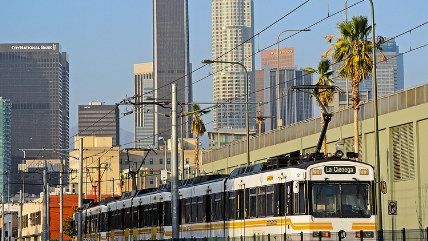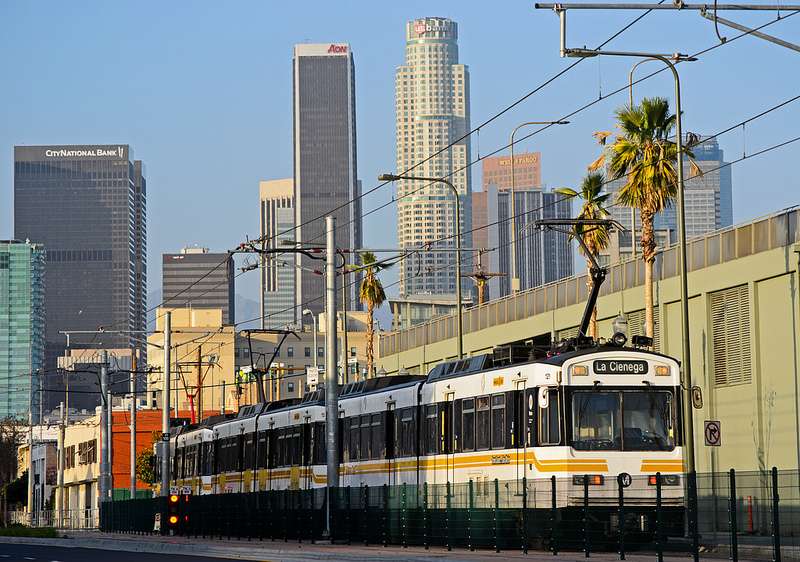Southern Californians Prefer Driving, Not Trains—News at Eleven
Mass transit use steadily dropping in greater Los Angeles area.


City planners in Los Angeles who think (albeit very incorrectly) that they have control over how residents live are famously pushing for general plan to "get people out of their cars" in this massive city and onto bikes or into mass transit and creating communities nestled around transit hubs. It's called their Mobility Plan 2035. It would recast the city with a heavy emphasis on pedestrian and bicycle traffic, possibly at the expense of supporting motor vehicles.
There's a slight problem with such a plan: This does not appear to be how the citizens of Los Angeles actually want to live. Use of mass transit in Los Angeles and Orange County continues to decline even as more and more money is thrown at it. To the extent that residents rely on mass transit, they seem to prefer buses to light rail, and when the costs of riding buses goes up and the availability or quality of service goes down, riders take a hike. From the Los Angeles Times:
The Los Angeles County Metropolitan Transportation Authority, the region's largest carrier, lost more than 10% of its boardings from 2006 to 2015, a decline that appears to be accelerating. Despite a $9-billion investment in new light rail and subway lines, Metro now has fewer boardings than it did three decades ago, when buses were the county's only transit option.
Most other agencies fare no better. In Orange County, bus ridership plummeted 30% in the last seven years, while some smaller bus operators across the region have experienced declines approaching 25%. In the last two years alone, a Metro study found that 16 transit providers in Los Angeles County saw average quarterly declines of 4% to 5%.
Officials say they think ridership will improve once everybody starts living according to their master plan of "walkable neighborhoods near transit stops." Mind you, "walkable neighborhoods near transit stops" has been the urban design holy grail since forever, but this time they really mean it! Others have doubts:
[S]ome experts say the downturn could represent a permanent shift in how people get around, propelled by a changing job market, falling gas prices, fare increases, declining immigration and the growing popularity of other transportation options, including bicycling and ride-hailing companies such as Uber and Lyft.
"I don't know if this is long-term, but it doesn't feel like it's temporary when we've been dealing with 36 straight months of declining ridership," said Darrell Johnson, chief executive of the Orange County Transportation Authority.
Call it the "libertarian moment" of transportation. People are choosing transportation models that work for them, not because it's what city planners would like for them to use. Light rail is one of the least flexible manifestations of mass transit, but look at the priorities of Los Angeles:
Although buses account for about 75% of Metro's ridership, rail operations and construction receive more money than buses do from Measure R, the county's most recent half-cent sales tax to fund transportation projects.
Metro has worked to speed up some bus routes, including giving buses their own lanes during rush hour on Wilshire Boulevard, the most traveled corridor in the county. The majority of buses, however, crawl through the streets at rush hour, and passengers often complain about long travel times.
"There's been lots of focus by transit agencies on shiny new things, sometimes at the expense of bus routes which serve the primary constituencies of transit agencies: low-wage workers," said Brian Taylor, the director of UCLA's Institute of Transportation Studies. "Lots of resources are being put into a few high-profile lines that often carry a smaller number of riders compared to bus routes."
Even poorer immigrants rely on mass transportation less and less the longer they live in the Los Angeles area. In addition, Metro has cut bus service by hundreds of thousands of hours and raised rates. Transit services in the region are now trying to figure out how to reverse this behavior and improve bus service, lower costs, and maybe even partner with ride-sharing services to bridge gaps in physical distance.
And of course, we love our cars. The amount of miles being driven in the area has returned to pre-recession levels. The Times story ends on the anecdote of a woman who moved to Los Angeles, used light rail for a few years, got robbed recently outside the city's newest light rail station in Culver City, got a car, and is much happier.
The aspiring actor said that getting a car resulted in "opening up her experiences in L.A." which must feel like a kick in the crotch of Los Angeles city planners. The demographics of their mobility plan start off by stating the exact opposite of what this trend is showing, stating that more people are looking for alternatives to driving.
The numbers the report show to justify this emphasis on walking and biking are kind of hilarious. They note that 64,000 people walk to work and 16,000 people bicycle to work. That's a 56 percent increase between 2000 and 2010. But the population of city of Los Angeles (just the city, not the surrounding county) is close to 4 million. Work commutes only account for 5 percent of all walking trips and 16 percent of all biking trips. But that means the city calculates about 100,000 people biking, less than one three percent of the city's population, over which they're considering making massive changes to streets.
There's one statistic reference in the plan that's particularly worth highlighting, because it demonstrates a particular mindset that shows the gap between planners and citizens. The report notes that 47 percent of all trips in greater Los Angeles are less than three miles, which they classify as "within walking/biking distance." It notes that 84 percent of these trips are currently made by car. This is clearly data being used to push the "get them out of the cars" mentality forward.
Let's talk about the privilege of the well-heeled urban elite for a moment. Time is a cost. These planners absolutely know that. They actually hope that traffic congestion will prompt more people to seek alternatives to driving because of how it affects their time. They recognize that losing time can be a significant inconvenience.
But when you're poor, unskilled labor, your time is almost all you have as a bargaining tool. Succeeding in low-level service jobs is often dependent on reliability, availability, and punctuality. Your time is what your employer needs from you and it is generally what he or she is paying you for. "Time is money" is not a metaphor.
The idea that people can just substitute a five-minute drive to travel three miles with a much longer bicycle ride or an extremely long walk is an example of privilege in action. Those who have to turn to mass transit as a necessity already lose a significant amount of time out of their "budget" waiting and transferring and dealing with the inconveniences. There is a sort of willfully blind absurdity in the idea that a significant number of Angelinos can just throw away an hour or so of their time for a three-mile trip. Maybe the type of people who come up with these goals can, but they seem fairly removed from the considerations of the average citizenry.
As for the city's efforts to force development over to planned transit hubs, they've hit a bit of a snag: Existing residents don't like the idea of giant, dense projects bulking up their neighborhoods. And in Los Angeles in particular (and California in general), NIMBY types (often wealthy urbanites) are able to use the courts to block projects. Right now there's an effort to put a measure on the ballot to force a moratorium on large new development projects that bypass existing zoning rules. It recently got the support of former Los Angeles Mayor Richard Riordan.
For a transportation plan that accommodates both drivers and the more popular bus transit for the needy in Los Angeles, check out the Reason Foundation's Increasing Mobility in Southern California: A New Approach. And watch below for an explanation why Los Angeles should stop trying to be like New York when it comes to transportation planning:
Oh, and one last thing to point out: The buses in Los Angeles operate on compressed natural gas (CNG), which burns more cleanly than gasoline. So when Los Angeles spends all its money on trains and cuts back on buses, prompting citizens to turn back to cars for transportation, this actually increases air pollution in the city. Something to keep in mind.


Show Comments (173)